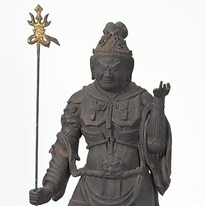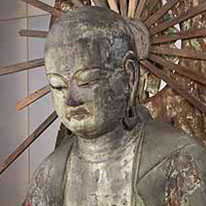Past Exhibitions
- Bishamonten and the Four Heavenly Kings
- January 2, 2022 - March 21, 2022
The Four Heavenly Kings are protectors of Buddhism who guard against evil forces from the four directions. They include Jikokuten (east), Zōchōten (south), Kōmokuten (west), and Tamonten (north). Tamonten is sometimes worshipped independently under the name of Bishamonten. The Four Heavenly Kings are viewed as powerful and efficacious deities who respond to prayers for victory in battle, but Bishamonten is also worshipped as one of the Seven Gods of Fortune (Shichifukujin), who are associated with wealth and good fortune. The expressive variety of sculptural forms seen in the images exhibited here reflect the diversity of beliefs and desires connected to the worship of these powerful deities.
- Japanese Sculpture
- January 2, 2022 - March 21, 2022
From ancient times through the Edo period (1615–1868), almost all subjects of Japanese sculpture were religious in nature. After Buddhism was introduced to Japan and became firmly established in the seventh century, the production of Buddhist statues flourished. Buddhist deities and their images often have origins in South Asia or Central Asia, and they were usually transmitted to Japan by way of China, bringing with them a complex array of foreign influences.
One of the distinctive characteristics of Japanese sculpture is its use of wood as a primary material. Various modes of carving and other techniques—including joint-block construction (yosegi-zukuri) and inlaid crystal eyes—were developed in Japan to create these wood images.
Over time, the repeated introduction of new images from the Asian continent contributed to further stylistic transformations and innovations in Japan. The Japanese Buddhist sculptures on view here reflect various styles of different historical periods.













